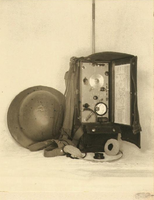








A walkie-talkie is a hand-held, portable, two-way radio transceiver. Its development during the Second World War has been variously credited to Donald L. Hings, radio engineer Alfred J. Gross, and engineering teams at Motorola.
Al Gross a Canadian who moved to the U.S. is also given credit by MIT for inventing the first Walkie-Talkie. In 1976 the U.S. government declassified Gross’ Top Secret mobile transceiver war time program.
The U.S. Army Signal Corps claim the first Military Walkie-Talkie SCR-194 was developed by their engineers prior to the war.
Walkie-talkies are widely used in any setting where portable radio communications are necessary, including business, public safety, military, outdoor recreation, and the like, and devices are available at numerous price points from inexpensive analog units sold as toys up to ruggedized (i.e. waterproof or intrinsically safe) analog and digital units for use on boats or in heavy industry. Most countries allow the sale of walkie-talkies for, at least, business, marine communications, and some limited personal uses such as CB radio, as well as for amateur radio designs. Walkie-talkies, thanks to increasing use of miniaturized electronics, can be made very small, with some personal two-way UHF radio models being smaller than a deck of cards (though VHF and HF units can be substantially larger due to the need for larger antennas and battery packs). In addition, as costs come down, it is possible to add advanced squelch capabilities such as CTCSS (analog squelch) and DCS (digital squelch) (often marketed as "privacy codes") to inexpensive radios, as well as voice scrambling and trunking capabilities. Some units (especially amateur HTs) also include DTMF keypads for remote operation of various devices such as repeaters. Some models include VOX capability for hands-free operation, as well as the ability to attach external microphones and speakers.
Consumer and commercial equipment differ in a number of ways; commercial gear is generally ruggedized, with metal cases, and often has only a few specific frequencies programmed into it (often, though not always, with a computer or other outside programming device; older units can simply swap crystals), since a given business or public safety agent must often abide by a specific frequency allocation. Consumer gear, on the other hand, is generally made to be small, lightweight, and capable of accessing any channel within the specified band, not just a subset of assigned channels.
Military organizations use handheld radios for a variety of purposes. Modern units such as the AN/PRC-148 Multiband Inter/Intra Team Radio (MBITR) can communicate on a variety of bands and modulation schemes and include encryption capabilities.